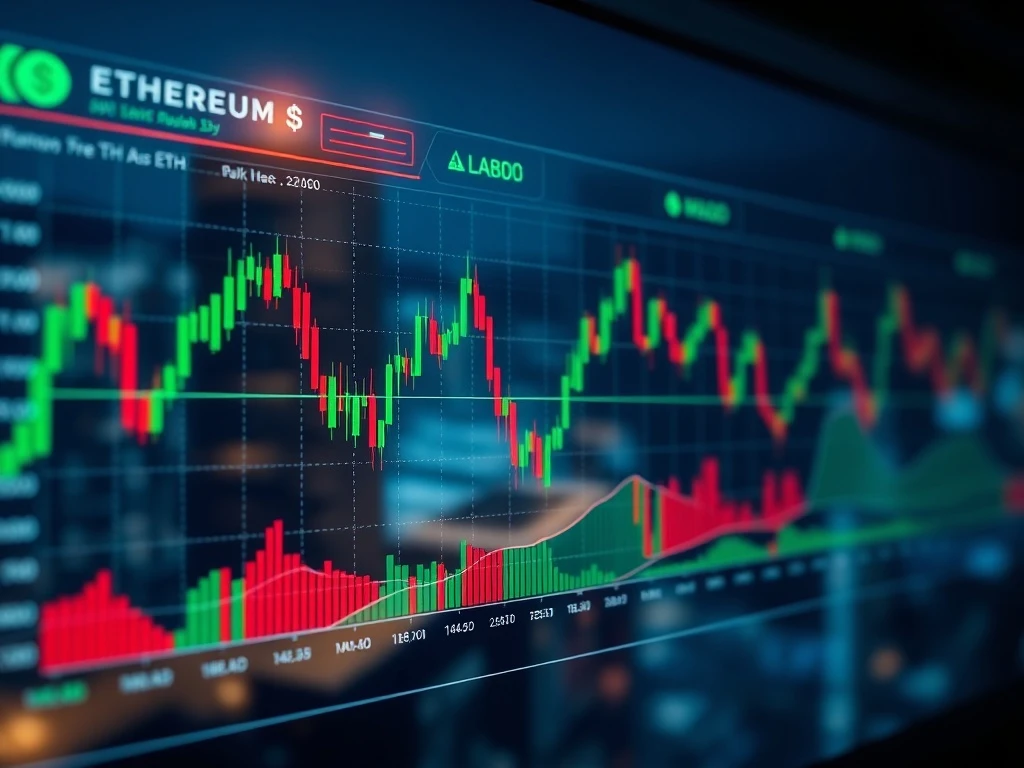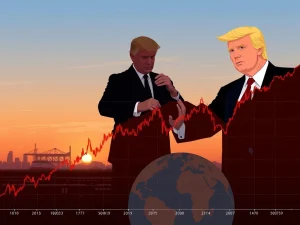Ethereum Price Analysis: Unlocking ETHUSDT’s Market Potential on July 27, 2025

Are you tracking Ethereum’s recent movements? The crypto market is always buzzing, and for Ethereum (ETHUSDT) enthusiasts, July 27, 2025, marked a significant period of price action and technical signals. Understanding these dynamics is crucial for making informed trading decisions in the volatile world of digital assets. Let’s break down the key events and indicators that shaped Ethereum’s performance.
Decoding Ethereum Price Movements: What Happened?
The past 24 hours for Ethereum (ETHUSDT) were a testament to its dynamic nature. Opening at 3729.02 on July 26, 2025, at 12:00 ET, ETH demonstrated a strong upward trajectory, closing at 3818.96 on July 27, 2025, at 12:00 ET. This move saw Ethereum reach a high of 3842.95, while finding robust support at a low of 3710.01. The total trading volume for this period stood at an impressive 188,609.1099 ETH, translating to a notional turnover of approximately $700,683,699.46, reflecting significant market participation.
This period was characterized by several notable price formations and technical confirmations:
- Bullish Engulfing Pattern: Early on July 26, Ethereum formed a bullish engulfing pattern near the 3725 level. This is a classic candlestick formation signaling a potential short-term reversal from a downtrend to an uptrend, often indicating strong buying interest.
- Key Resistance Test: A strong bearish rejection was observed at 3842.95 around 11:00 ET, highlighting this as a significant resistance level. Overcoming such levels often requires sustained buying pressure.
- Consolidation and Upward Bias: Following the resistance test, the price consolidated between 3790 and 3815, eventually closing near the upper end of this range. This suggests that despite the rejection, buyers maintained control, hinting at a possible continuation of the upward trend.
Leveraging Technical Indicators for ETHUSDT Insights
To truly understand Ethereum’s market health and predict potential future movements, traders often turn to a suite of technical indicators. These tools provide valuable insights into momentum, volatility, and support/resistance levels. Here’s what they revealed for ETHUSDT:
Moving Averages: Confirming the Uptrend
Moving averages are fundamental tools for identifying trends. On the 15-minute chart, the 20-period and 50-period moving averages crossed above 3740. This ‘golden cross’ on a shorter timeframe typically reinforces a bullish bias, indicating that the short-term price momentum is strong and likely to continue. Furthermore, on the daily chart, Ethereum closed decisively above both its 50-day and 100-day moving averages. This is a powerful signal for a medium-term uptrend, suggesting sustained investor confidence and accumulation.
MACD & RSI: Momentum and Overbought Conditions
The Moving Average Convergence Divergence (MACD) and Relative Strength Index (RSI) are crucial momentum oscillators:
- MACD: The MACD crossed into positive territory during the 05:30–07:00 ET window, perfectly aligning with the significant price surge observed during that period. A positive MACD reading indicates bullish momentum is gaining strength, as the short-term moving average moves above the longer-term one.
- RSI: The RSI, which measures the speed and change of price movements, reached overbought levels (above 70) during the 10:45–11:00 ET window. While strong momentum is evident, an overbought RSI suggests that the asset might be due for a pullback or a period of consolidation. Traders should exercise caution, as a short-term correction could occur before the uptrend resumes.
Bollinger Bands: Volatility and Pressure
Bollinger Bands are excellent for gauging volatility and identifying potential overbought or oversold conditions relative to the average price:
- Expansion: The bands expanded significantly during the 05:30–07:00 ET window, reflecting a sharp increase in market volatility. This expansion often accompanies strong price movements, indicating that the market is experiencing a period of high energy.
- Upper Band Touch: Ethereum’s price closed near the upper band at 3818.96. This is a clear sign of strong buying pressure, as the price is pushing against the upper boundary of its typical trading range.
- Future Outlook: A subsequent contraction in band width could signal a period of consolidation, where the market digests recent gains before the next major directional move.
Volume & Turnover: Confirming Conviction in Trading Strategies
Volume is the lifeblood of any market, confirming the conviction behind price movements. For ETHUSDT, volume spiked notably during two key windows: 10:45–11:00 ET and 12:00–12:30 ET. These spikes confirmed the breakout above the 3815 level, indicating that the price appreciation was supported by strong institutional and retail interest. Notional turnover also increased proportionally during these periods, reinforcing the validity of the move. The absence of significant divergence between volume and price suggests that the upward move was genuine and driven by strong buying conviction, rather than speculative or low-volume pushes.
Fibonacci Retracements: Identifying Key Support and Resistance
Fibonacci retracement levels are critical for identifying potential support and resistance zones based on previous price swings. For Ethereum, these levels provided clear insights:
- 38.2% Retracement (3765–3770): This level acted as reliable support during the 04:00–05:00 ET window, preventing further downside and indicating renewed buying interest at this point.
- 61.8% Retracement (3805–3810): This level was tested during the 14:00–14:30 ET window and held firm, suggesting strong demand within this range and reinforcing its role as a key demand zone.
- Next Key Level (3835–3840): Looking ahead, the 3835–3840 range is identified as the next crucial Fibonacci level that could act as significant resistance in the coming 24 hours. A decisive break above this level would signal a continuation of the strong bullish momentum.
What’s Next for Ethereum (ETHUSDT)?
Ethereum appears to be in a strong short-term uptrend, with the confluence of technical indicators and robust volume confirming the recent price appreciation. The bullish engulfing pattern, positive MACD, expanding Bollinger Bands, and strong volume support paint a promising picture. However, the overbought conditions indicated by the RSI and the presence of key resistance levels, particularly around 3835–3840, introduce an element of caution.
Investors and traders should closely monitor the 3835–3840 range as a potential resistance point. A decisive break above this could open the path to higher price targets. Conversely, the 3790–3795 levels should be watched as immediate support. A failure to hold these levels could trigger a short-term correction. As always, volatility remains a inherent risk in the crypto market, and a correction could occur if the 3810–3815 support level fails to hold. Diligent risk management and continuous monitoring of these key levels are essential for navigating the dynamic Ethereum market.
Frequently Asked Questions (FAQs)
Q1: What does a ‘bullish engulfing pattern’ signify for Ethereum price?
A bullish engulfing pattern is a strong candlestick formation that typically signals a reversal of a downtrend. It occurs when a large green (or white) candlestick completely ‘engulfs’ the previous small red (or black) candlestick, indicating that buyers have strongly taken control from sellers, often leading to upward price movement.
Q2: Why is volume important when analyzing ETHUSDT’s price movements?
Volume is crucial because it confirms the strength and conviction behind price movements. A price increase on high volume suggests strong buying interest and a valid move, while a price increase on low volume might indicate a weak, unsustainable rally. For ETHUSDT, high volume spikes confirmed the recent breakout, lending credibility to the upward trend.
Q3: What do ‘overbought conditions’ mean for Ethereum’s short-term outlook?
Overbought conditions, often indicated by the Relative Strength Index (RSI) exceeding 70, suggest that Ethereum’s price has risen too quickly and may be due for a short-term pullback or consolidation. While not a direct sell signal, it warns traders to be cautious, as the upward momentum might temporarily slow down or reverse.
Q4: How do Fibonacci retracement levels help in trading Ethereum?
Fibonacci retracement levels are horizontal lines that indicate where support and resistance are likely to occur. They are based on Fibonacci sequences and are derived by drawing lines at 23.6%, 38.2%, 50%, 61.8%, and 78.6% of a previous significant price move. For Ethereum, these levels helped identify key price points where demand (support) or supply (resistance) might be found, guiding entry and exit strategies.
Q5: What are the key price levels to watch for ETHUSDT in the near term?
Based on recent analysis, traders should closely monitor the 3835–3840 range as a significant resistance level. On the support side, the 3790–3795 range is important, with 3810–3815 also acting as a critical support. Breaking above resistance or failing to hold support could dictate the next major directional move for Ethereum.








